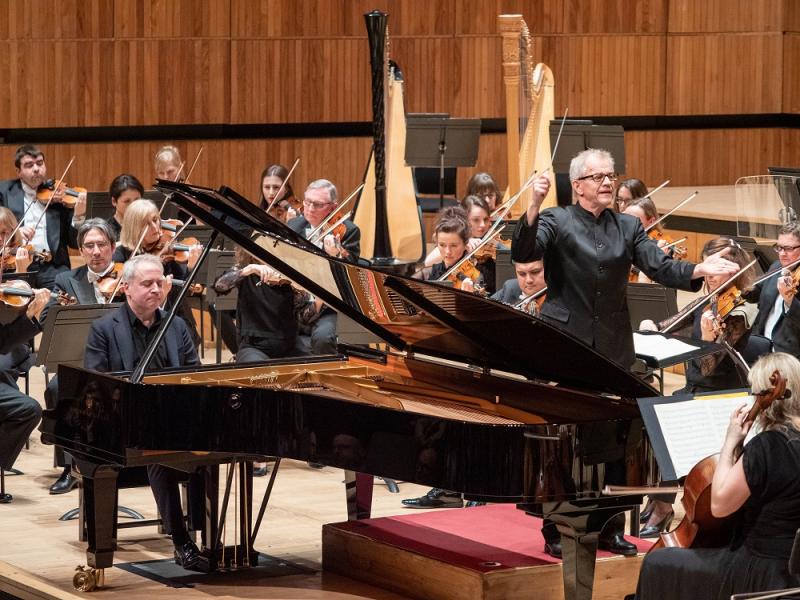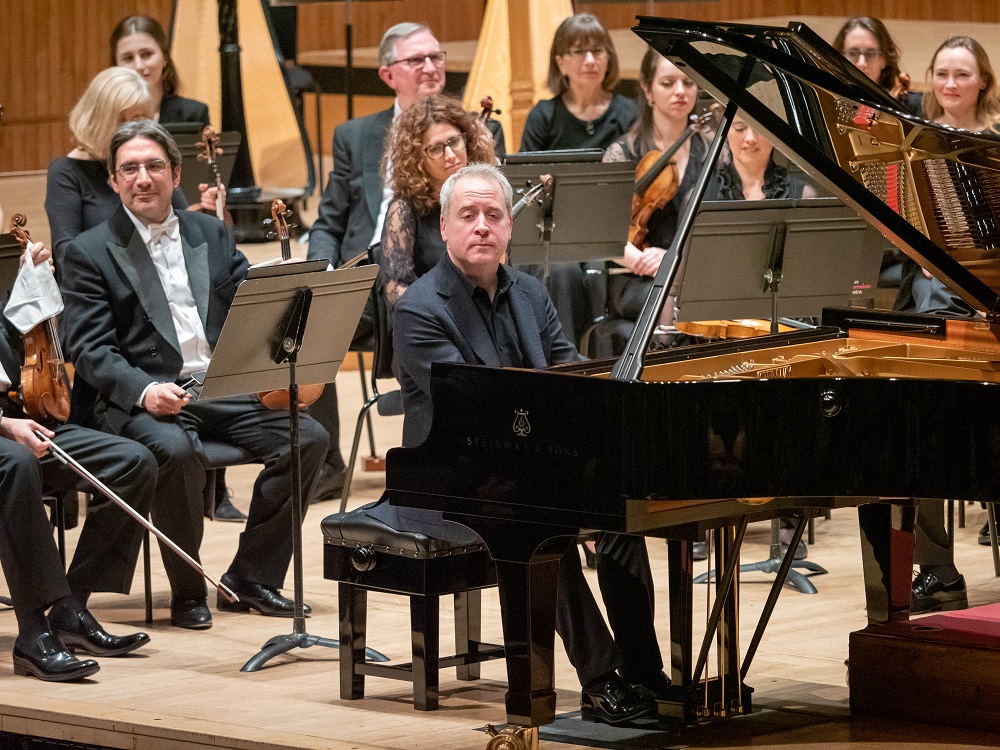Denk, LPO, Vänskä, RFH review - 200 years of joy and sorrow | reviews, news & interviews
Denk, LPO, Vänskä, RFH review - 200 years of joy and sorrow
Denk, LPO, Vänskä, RFH review - 200 years of joy and sorrow
A febrile odyssey from fresh Beethoven to over-the-rainbow Enescu

Three works two centuries apart, two of them rarities, with 100/200 years between each: that's no guarantee for programming success, and no way to fill a hall (though the London Philharmonic Orchestra admin deserves a good medal for the intricacy of its “2020 Vision” series planning, linked to the Beethoven anniversary and explained by Gavin Dixon in his review of Vladimir Jurowski’s launch concert earlier this month)
There was even riveting restlessness where you might have expected fixity, in the 2005 contender, Penderecki’s Chaconne in memory of John Paul II (whom the composer knew as Karol Wojyla during the future Pope’s theatre days). A late addition to the ongoing project of his Polish Requiem, which started out as a single memorial movement dedicated to Lech Wałęsa in 1980 in memory of the workers killed a decade earlier at the Gdańsk shipyards, the variations on a descending bass quickly depart from the melodic baroque model, threatening fragmentation before the poised, poetic close with two brief solos for viola (Richard Waters) and cello (Kristine Blaumane, who also made her presence felt in Beethoven’s finale; the cellist with her colleagues and Vänskä in third photograph). The writing for strings is superb but tricky; the LPO players combined both atmosphere and focus.
I can only conclude that this singular road to Rome triggered Jeremy Denk’s wicked encore at the end of the first half, for symmetry’s sake – a paraphrase (not sure whose – his own?) on the Pilgrims’ Chorus from Wagner’s Tannhäuser which you knew was going to go wrong from its slightly off chords before it rocketed into a parallel homage to Tom Lehrer’s “Vatican Rag” (“2-4-6-8, time to transubstantiate”). Surely Denk could have sung as well as played that, too, since he’s consummate in reaching out to the audience.  He probably doesn’t know Eric Morecambe’s deadpan out-front eyebrow raisings, which made me want to laugh in the equivalent version here during the Beethoven concerto. But they were not out of place: Denk’s razor-sharp responses to his fellow players – and Vänskä is a master at working with soloists in concertos – had plenty of humour to them, laugh-out-loud funny in sudden flashes throughout the finale. The whole felt Mozartian: not in the pretty-rococo-image way, but as I want to hear the earlier composer – muscular, no slack, but with enough room for poetics. That was even true of the deadly-serious exchanges between Orpheus and the Furies which form such a unique centrepiece.
He probably doesn’t know Eric Morecambe’s deadpan out-front eyebrow raisings, which made me want to laugh in the equivalent version here during the Beethoven concerto. But they were not out of place: Denk’s razor-sharp responses to his fellow players – and Vänskä is a master at working with soloists in concertos – had plenty of humour to them, laugh-out-loud funny in sudden flashes throughout the finale. The whole felt Mozartian: not in the pretty-rococo-image way, but as I want to hear the earlier composer – muscular, no slack, but with enough room for poetics. That was even true of the deadly-serious exchanges between Orpheus and the Furies which form such a unique centrepiece.
The LPO already has form under Jurowski in the complexities of Romanian master Enescu – we won’t hear a more intricately jewelled interpretation of his great opera Oedipe, and it’s good news that Jurowski’s championship of the Third Symphony is returning later in this series. The First of 1905 may be late-romantic in its opulent scoring, but resolutely un-decadent. Enescu is absolutely his own man here: themes flash and disappear into the tapestry, definition in block chords is soon submerged in iridescent waters, little is easy to grasp yet everything enthrals, and Vänskä seemed hyper-alive to all the wonders.  It’s visual rather than cinematic music: an exotic garden rises from the gloomy vaults of a Maeterlinck castle in the central slow movement, which may be seeded by Wagner’s Tristan und Isolde but contains its own unique plant species. Even in the finale, which starts and ends like the first movement in brilliant E flat major assertiveness, strange woodwind tendrils pop out from the rock face when you least expect them. So unique was this glorious endgame that I wanted to hear it all over again: that’s the wonder of Enescu, and the LPO is now officially his greatest champion.
It’s visual rather than cinematic music: an exotic garden rises from the gloomy vaults of a Maeterlinck castle in the central slow movement, which may be seeded by Wagner’s Tristan und Isolde but contains its own unique plant species. Even in the finale, which starts and ends like the first movement in brilliant E flat major assertiveness, strange woodwind tendrils pop out from the rock face when you least expect them. So unique was this glorious endgame that I wanted to hear it all over again: that’s the wonder of Enescu, and the LPO is now officially his greatest champion.
Add comment
The future of Arts Journalism
You can stop theartsdesk.com closing!
We urgently need financing to survive. Our fundraising drive has thus far raised £49,000 but we need to reach £100,000 or we will be forced to close. Please contribute here: https://gofund.me/c3f6033d
And if you can forward this information to anyone who might assist, we’d be grateful.

Subscribe to theartsdesk.com
Thank you for continuing to read our work on theartsdesk.com. For unlimited access to every article in its entirety, including our archive of more than 15,000 pieces, we're asking for £5 per month or £40 per year. We feel it's a very good deal, and hope you do too.
To take a subscription now simply click here.
And if you're looking for that extra gift for a friend or family member, why not treat them to a theartsdesk.com gift subscription?
more Classical music
 Kohout, Spence, Braun, Manchester Camerata, Huth, RNCM, Manchester review - joy, insight, imagination and unanimity
Celebration of the past with stars of the future at the Royal Northern College
Kohout, Spence, Braun, Manchester Camerata, Huth, RNCM, Manchester review - joy, insight, imagination and unanimity
Celebration of the past with stars of the future at the Royal Northern College
 Jansen, LSO, Pappano, Barbican review - profound and bracing emotional workouts
Great soloist, conductor and orchestra take Britten and Shostakovich to the edge
Jansen, LSO, Pappano, Barbican review - profound and bracing emotional workouts
Great soloist, conductor and orchestra take Britten and Shostakovich to the edge
 Jakub Hrůša and Friends in Concert, Royal Opera review - fleshcreep in two uneven halves
Bartók kept short, and a sprawling Dvořák choral ballad done as well as it could be
Jakub Hrůša and Friends in Concert, Royal Opera review - fleshcreep in two uneven halves
Bartók kept short, and a sprawling Dvořák choral ballad done as well as it could be
 Hadelich, BBC Philharmonic, Storgårds, Bridgewater Hall, Manchester review - youth, fate and pain
Prokofiev in the hands of a fine violinist has surely never sounded better
Hadelich, BBC Philharmonic, Storgårds, Bridgewater Hall, Manchester review - youth, fate and pain
Prokofiev in the hands of a fine violinist has surely never sounded better
 Monteverdi Choir, ORR, Heras-Casado, St Martin-in-the-Fields review - flames of joy and sorrow
First-rate soloists, choir and orchestra unite in a blazing Mozart Requiem
Monteverdi Choir, ORR, Heras-Casado, St Martin-in-the-Fields review - flames of joy and sorrow
First-rate soloists, choir and orchestra unite in a blazing Mozart Requiem
 Cho, LSO, Pappano, Barbican review - finely-focused stormy weather
Chameleonic Seong-Jin Cho is a match for the fine-tuning of the LSO’s Chief Conductor
Cho, LSO, Pappano, Barbican review - finely-focused stormy weather
Chameleonic Seong-Jin Cho is a match for the fine-tuning of the LSO’s Chief Conductor
 Classical CDs: Shrouds, silhouettes and superstition
Cello concertos, choral collections and a stunning tribute to a contemporary giant
Classical CDs: Shrouds, silhouettes and superstition
Cello concertos, choral collections and a stunning tribute to a contemporary giant
 Appl, Levickis, Wigmore Hall review - fun to the fore in cabaret and show songs
A relaxed evening of light-hearted fare, with the accordion offering unusual colours
Appl, Levickis, Wigmore Hall review - fun to the fore in cabaret and show songs
A relaxed evening of light-hearted fare, with the accordion offering unusual colours
 Lammermuir Festival 2025, Part 2 review - from the soaringly sublime to the zoologically ridiculous
Bigger than ever, and the quality remains astonishingly high
Lammermuir Festival 2025, Part 2 review - from the soaringly sublime to the zoologically ridiculous
Bigger than ever, and the quality remains astonishingly high
 BBC Proms: Ehnes, Sinfonia of London, Wilson review - aspects of love
Sensuous Ravel, and bittersweet Bernstein, on an amorous evening
BBC Proms: Ehnes, Sinfonia of London, Wilson review - aspects of love
Sensuous Ravel, and bittersweet Bernstein, on an amorous evening
 Presteigne Festival 2025 review - new music is centre stage in the Welsh Marches
Music by 30 living composers, with Eleanor Alberga topping the bill
Presteigne Festival 2025 review - new music is centre stage in the Welsh Marches
Music by 30 living composers, with Eleanor Alberga topping the bill
 Lammermuir Festival 2025 review - music with soul from the heart of East Lothian
Baroque splendour, and chamber-ensemble drama, amid history-haunted lands
Lammermuir Festival 2025 review - music with soul from the heart of East Lothian
Baroque splendour, and chamber-ensemble drama, amid history-haunted lands

Comments
Jeremy Denk's encore of
Thank you - I don't know the
Thank you - I don't know the name. I was hoping he was semi-improvising but the main thing is that he gave that impression. There are some wacky pop-ifications of Wagner by the piano duo Wiener and Doucet.